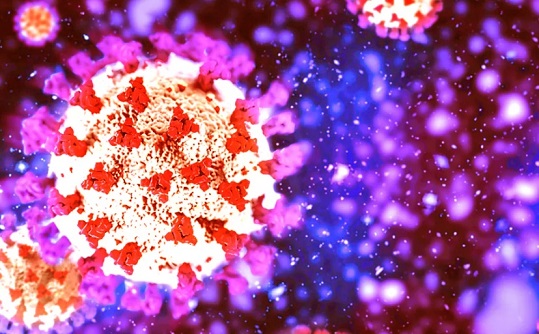Nikhil Prasad Fact checked by:Thailand Medical News Team Jan 02, 2025 10 months, 2 weeks, 1 day, 9 hours, 31 minutes ago
Medical News: Neuropilin One and Its Significance in COVID-19
A breakthrough study by researchers from RayBiotech Inc., University of Georgia-USA, and Weill Cornell Medical School-USA has unraveled critical insights into the role of Neuropilin-1 (NRP1) in SARS-CoV-2 infection. This receptor, long known for its role in vascular and neural functions, has emerged as a significant player in the entry of the virus that causes COVID-19. While much of the focus has been on ACE2 as the primary receptor, this research reveals how glycosylation of NRP1 plays a vital role in facilitating viral entry, especially in tissues with low ACE2 expression.
 Neuropilin One Glycosylation Role in COVID-19 Infection
Neuropilin One Glycosylation Role in COVID-19 Infection
This
Medical News report sheds light on the detailed glycosylation patterns of NRP1, a transmembrane receptor, and their implications for SARS-CoV-2 infectivity. The study utilized advanced glycoproteomic techniques, including mass spectrometry and mutagenesis, to explore the interaction between NRP1 and the viral spike protein.
The Glycosylation Process and Its Impact on Viral Entry
Proteins such as NRP1 undergo glycosylation, a post-translational modification involving the addition of sugar molecules. This process is crucial for protein stability, folding, and interactions. The study identified three key N-linked glycosylation sites (N150, N261, and N522) on NRP1 that are essential for the binding of the SARS-CoV-2 spike protein. Additionally, novel O-linked glycosylation sites (S612, S637, T638, and S641) were discovered, though their precise roles require further investigation.
Through site-directed mutagenesis, researchers demonstrated that mutations at these glycosylation sites significantly reduce the spike protein's binding efficiency. The functional importance of glycosylation was also evident in pseudovirus assays, which showed a dramatic decrease in viral entry when glycosylation at specific sites was disrupted.
Key Findings from the Study
The researchers employed advanced techniques to map glycosylation sites and assess their functional roles:
-Identification of Critical Glycosylation Sites: The study pinpointed three N-linked sites (N150, N261, and N522) and multiple O-linked sites. These sites were characterized using mass spectrometry, revealing unique glycan structures crucial for viral binding.
-Role in Viral Entry: Mutations at N150 and N261 led to a 50% reduction in viral infectivity, underscoring their role in facilitating viral entry.
-Immune Modulation: The glycosylation sites also influenced the regulation of interleukin-6 (IL-6), a cytokine associated with severe COVID-19. Mutants lacking glycosylation exhibited lower IL-6 levels, suggesting a link between glycosylation and immune response modulation.
Implications for Therapeutic Development
The findings suggest that targeting glycosylation on NRP1 co
uld offer a novel antiviral strategy. By inhibiting specific glycan modifications, it may be possible to reduce viral entry and mitigate the cytokine storm associated with severe COVID-19. The study also highlights the potential for developing therapeutic agents that disrupt spike-NRP1 interactions, providing an additional layer of protection against SARS-CoV-2.
Conclusions
This study provides a comprehensive glycoproteomic map of NRP1, highlighting the critical role of glycosylation in SARS-CoV-2 entry and immune response modulation. It reveals how the virus exploits glycan modifications on host receptors to enhance infectivity, offering new avenues for therapeutic intervention.
Future research should focus on developing inhibitors targeting NRP1 glycosylation and exploring its interactions with other co-receptors. Understanding these mechanisms could pave the way for broader antiviral strategies against current and emerging coronaviruses.
The study findings were published on a preprint server and are currently being peer reviewed.
https://papers.ssrn.com/sol3/papers.cfm?abstract_id=5076086
For the latest COVID-19 News, keep on logging to Thailand
Medical News.
Read Also:
https://www.thailandmedical.news/news/university-of-bristol-study-discovers-that-neuropilin-1-is-a-host-factor-for-sars-cov-2-infectivity-involving-the-escpe-1-endosomal-sorting-pathway
https://www.thailandmedical.news/news/breaking-brazil-study-provides-evidence-that-sars-cov-2-infects-the-astrocytes-of-the-human-brain-using-nrp1-receptors-and-causes-damage
https://www.thailandmedical.news/news/sars-cov-2-and-cancer-increased-neuropilin-1-expression-as-a-result-of-covid-19-can-lead-to-progression-of-primary-brain-tumors-besides-neurological-i
https://www.thailandmedical.news/news/study-reveals-that-i210t,-v213g,-s371f,-s373p,-t478k,-f486v,-y505,-d796y-mutations-enhances-sars-cov-2-binding-with-ace2-and-nrp1-receptors
https://www.thailandmedical.news/news/y505h-spike-mutation-found-in-new-sars-cov-2-sub-lineages-circulating-in-pakistan-enhances-binding-with-both-ace2-and-nrp1-receptors
https://www.thailandmedical.news/news/covid-19-news-chinese-researchers-warn-that-sars-cov-2-could-be-infecting-cattle-and-other-animals-via-axl-and-nrp1-receptors
